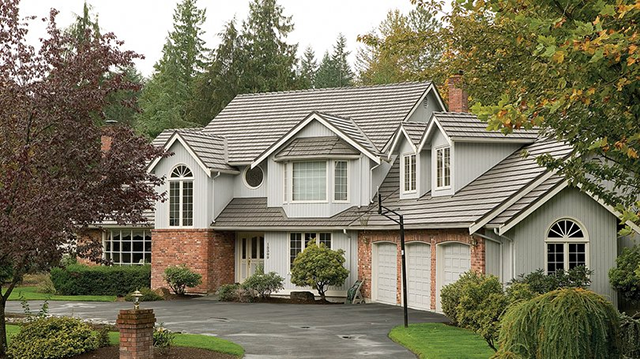
Research shows homeowners need to understand the consequences of choosing their next roof
This Earth Day, homeowners who want to reduce pollution should look up… at their roofs.
A recent Yale study has found that asphalt—found on the roofs of millions of homes and millions of miles of roads in the U.S. and Canada—can create urban air pollution that is comparable to motor vehicle emissions.
And that’s just part of the problem. It is estimated that more than 13 million tons of asphalt shingles get dumped in landfills each year. Even “innovative” new manufacturing attempts to solve the asphalt shingle roofing recycling problem are estimated to only contain about 15 percent recycled materials (and just as concerning, performance and longevity standards have yet to be proven). The problem is even worse in regions prone to hail, hurricane, and climate related disasters due to asphalt failing under such extreme conditions such as in Florida.
While asphalt shingle waste also has been reused for paving of roads, estimates say this use accounts for under 10 percent of the total asphalt shingle waste (only 31 states currently allow for this, and percentages vary greatly with many falling well under 10 percent, according to a 2017 U.S. Department of Transportation report). Some may question if this is an environmentally viable solution, considering Yale research findings that asphalt-related emissions from roads and roofing add significantly to air pollution, especially on hot and sunny days.
More sustainable solutions
Metal has an infinite ability to be recycled, meaning it has an unlimited lifespan. It is one of the only materials in the world that can be recycled again and again, without compromising its qualities.
That makes metal roofs very sustainable. But metal roofs also offer another environmental advantage: Their ability to save energy—and not just on heating and cooling costs—but as a benefit of the recycling process itself.
According to the Metal Construction Association1, recycling decreases the amount of energy required to produce metal products like metal roofing. For example, producing aluminum from recycled material requires only 5 percent of the energy required to produce aluminum from originally sourced bauxite ore and every ton of recycled aluminum saves four tons of bauxite. Using recycled aluminum instead of mining for new materials also reduces air pollution by an estimated 95 percent and water pollution by an estimated 97 percent.
Copper is also routinely recycled, with the highest scrap value of any building metal. The scrap is melted down and reformed into new, appropriate products including metal roofing. This re-melting takes only an estimated 15 percent of the total energy consumed in mining, milling, smelting, and refining copper from ore.
At the end of its very long life, a metal roof is 100 percent recyclable. When choosing a metal roof, consumers can do their part in completing the loop by asking prospective metal roofing installers how much recycled content is used in the manufacturing of products they are installing, to help identify the most sustainable option possible. The minimum amount of recycled content metal roofs contain is 25 percent, and most have percentages that are substantially higher.
“Metal roofing is a time-tested solution. It’s been used for centuries around the globe,” said Renee Ramey, MRA executive director. “Homeowners who choose quality metal roofs made with high levels of recycled content are not only helping reduce environmental impacts but are improving the performance of their home as well.”
Ramey points out that other benefits of quality metal roofs include the fact they can last 50-plus years and many are considered “Cool Roofs,” helping homeowner save on energy costs. They also reduce the need for harsh, environmentally damaging maintenance and cleaning techniques, and they are exceptionally strong and resilient, able to withstand hurricane force winds, wildfire dangers, hail, ice and snow.
How metal recycling works
When recycling a metal roof, homeowners should look for local metal recycling resources in their area or ask their installer if they provide such a service. Once the metal is received, recyclers first sort it based on its quality and material type. The metal is compacted to save room and then shredded or broken down into smaller pieces to be melted in a way that requires less energy. Steel is typically formed into blocks, while aluminum is rolled into sheets. The scrap is then melted in a large furnace which does require energy, but much less than what it takes to make raw materials. Metals are then purified and transported to different mills to be remade into new products.
“It’s the ultimate goal of recycling in action,” said Ramey. “Unlike asphalt or other roofing materials, the need for raw materials and energy for manufacturing is greatly reduced, and reusing metal again and again will not impact its performance qualities, now or in the future.”
1. *Source: Technical Brief: Recycled Content of Metal Roofing and Siding Panels, Metal Construction Association